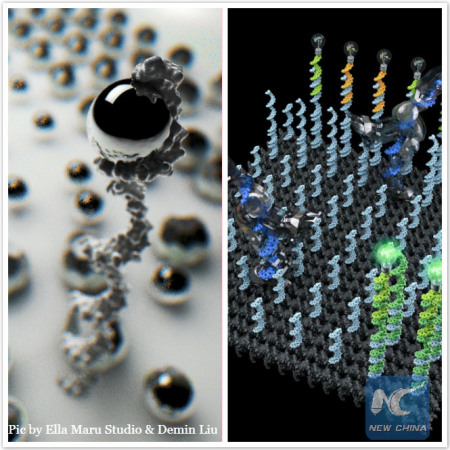
Left: Conceptual illustration of a DNA robot sorting two types of cargos. (Credit: Ella Maru Studio) Right: Conceptual illustration of two DNA robots collectively performing a cargo-sorting task on a DNA origami surface, transporting fluorescent molecules with different colors from initially unordered locations to separated destinations. (Credit: Demin Liu)
Scientists have created miniature robots out of DNA that can autonomously "walk" around a surface, pick up certain molecules and drop them off in designated locations, a new study published Thursday in the U.S. journal Science said.
"Just like electromechanical robots are sent off to faraway places, like Mars, we would like to send molecular robots to minuscule places where humans can't go, such as the bloodstream," said LuLu Qian, assistant professor of bioengineering of the California Institute of Technology.
Such technology could one day be used for a wide range of applications, including synthesizing therapeutic chemicals in an artificial molecular factory, delivering drugs in bloodstreams or cells, or sorting molecular components in trash for recycling, Qian said.
To create a DNA robot, Qian's team constructed three basic building blocks, including a "leg" with two "feet" for walking, an "arm" and "hand" for picking up cargo, and a segment that can recognize a specific drop-off point and signal to the hand to release its cargo.
Each of these components is made of just a few nucleotides within a single strand of DNA.
In principle, these modular building blocks could be assembled in many different ways to complete different tasks.
For example, a DNA robot with several hands and arms, could be used to carry multiple molecules simultaneously.
In the work described in the Science paper, the Qian group built a robot that could explore a molecular surface, pick up two different molecules and then distribute them to two distinct regions on the surface.
"The DNA robot moves around on a 58-nanometer-by-58-nanometer pegboard on which the pegs are made of single strands of DNA complementary to the robot's leg and foot," Qian's team said in a statement.
"The robot binds to a peg with its leg and one of its feet -- the other foot floats freely," the team said.
"When random molecular fluctuations cause this free foot to encounter a nearby peg, it pulls the robot to the new peg and its other foot is freed. This process continues with the robot moving in a random direction at each step."
Since one step for the little guy takes five minutes, and allows it to move six nanometers, it may take a day for the robot to explore the entire board, the team said.
"Along the way, as the robot encounters cargo molecules tethered to pegs, it grabs them with its 'hand' components and carries them around until it detects the signal of the drop-off point," it said.
"The process is slow, but it allows for a very simple robot design that utilizes very little chemical energy."
In a summary on the robot, the Science magazine called Qian's work "one small step for a DNA robot, one giant leap for mankind.
"The future is here," the summary wrote.


















































